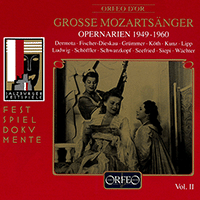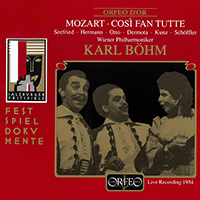Irmgard Seefried
The daughter of well-educated Austrians, Seefried received her initial music lessons from her father. She made her first public appearance when she was eight years old and three years later sang Gretel / Hänsel und Gretel in a children’s performance of Humperdinck’s opera. She studied singing at the Augsburg Conservatory, first with Albert Mayer and then with Paola Novikova, a relationship which continued after she had become established.
Seefried made her operatic debut in 1940, as a Priestess / Aida at the Aachen Municipal Theatre; here she worked closely with the music director, Herbert von Karajan, and sang in Aachen Cathedral under its director of music, Theodor Rehmann. Her roles at Aachen included Nuri / Tiefland and even, under Karajan, Donna Anna / Don Giovanni—only possible for her because of the theatre’s small size and her lyric approach to this dramatic role. She joined the Vienna State Opera in 1943, making her debut as Eva / Die Meistersinger von Nürnberg under Karl Böhm and remaining with this company for the rest of her professional career.
Despite difficult living conditions in Vienna, Seefried established herself as singer of great promise, for instance as a peerless Composer / Ariadne auf Naxos, again conducted by Böhm when especially mounted for Richard Strauss’s eightieth birthday in 1944. Although principally known for her singing of Mozart her repertoire was quite extensive and included the title roles in Madama Butterfly and Kát’a Kabanová, Marie / Wozzeck, Blanche / Dialogues des Carmélites, Cleopatra / Giulio Cesare and Octavian / Der Rosenkavalier. She was a member of the Vienna State Opera ensemble which in 1947 toured to London, where she sang Fiordiligi / Così fan tutte and Susanna / Le nozze di Figaro at the Royal Opera House.
At the Salzburg Festival Seefried made her debut in 1946 as Pamina / Die Zauberflöte, which became a central role for her. She appeared at Salzburg annually until 1964, (except for 1955, 1961 and 1962) as Pamina, Susanna, Fiordiligi, Zerlina / Don Giovanni, Marzelline / Fidelio and the Composer. She also participated in many concerts and gave numerous recitals at the festival.
It was as Susanna that Seefried made her debut at La Scala, Milan in 1949 and at the Metropolitan Opera in the 1953–1954 season. These were to be her only performances at the Met, although when reviewing her performance for the New York Herald Tribune, Virgil Thomson was enthusiastic: ‘Vocal security and stage assurance were hers in abundance.’ She returned to America to appear with the Chicago Lyric Opera as Zerlina and Marzelline in 1961 and as the Composer in 1964.
In Europe, outside of her work in Vienna, Seefried returned to Covent Garden as Octavian in 1962, sang the Composer at the Aix-en-Provence Festival in 1963 and Marie at Stuttgart in 1966. She gave her farewell performance as Kát’a Kabanová in Vienna in 1976. She taught at both the Vienna Academy of Music and at the Salzburg Mozarteum, while in addition to her operatic work she performed extensively in concert and in recitals, being especially renowned for her singing of lieder.
She was blessed with an extremely beautiful voice and sang with a very natural quality – in interview Elisabeth Schwarzkopf commented that Seefried was able to do effortlessly what other singers, including herself, worked all their lives to do. She married the distinguished Austrian violinist Wolfgang Schneiderhan in 1948, with whom she had three children.
© Naxos Rights International Ltd. — David Patmore (A–Z of Singers, Naxos 8.558097-100).












































